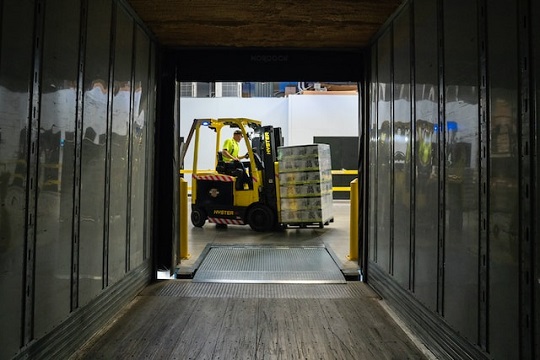In today’s fast-paced world, you understand that logistics plays a pivotal role in ensuring the seamless flow of goods and services from one point to another.
However, you also know that the constant challenges of traffic jams in urban areas can significantly hinder your logistics efficiency, causing delays, increased costs, and customer dissatisfaction.
In this blog post, we will delve into the art of keeping your logistics efficiency intact when navigating through traffic jam routes.
We will explore the root causes of traffic congestion, discuss its impact on your logistics operations, and provide you with a comprehensive guide of strategies and solutions to tackle these challenges effectively.
But, before we delve deeper into this topic, make sure you have also followed my LinkedIn account to gain more insights on supply chain management.
Table of Contents
Understanding the Causes and Impact of Traffic Jams
As you explore the topic of traffic jams and their impact on logistics efficiency, it is crucial for you to understand the root causes and consequences of these congestions.
Traffic jams in urban areas can be caused by several factors, such as increased population, inadequate infrastructure, road construction, accidents, and adverse weather conditions.
Each of these bottlenecks has a significant influence on your supply chain, resulting in delayed deliveries, higher fuel consumption, increased maintenance costs, and potentially leading to frustration among your employees.
By comprehending these causes and their implications, you can better prepare and implement strategies to mitigate their effects on your logistics operations.
Utilizing Real-time Data and Technology
As a logistics manager, you have access to one of the most potent tools in your arsenal: real-time data and technology.
By leveraging advanced tracking systems, GPS, and traffic monitoring applications, you can gain valuable insights into current road conditions and traffic patterns.

This information empowers you to make informed decisions, such as rerouting deliveries to avoid congested areas, adjusting schedules accordingly, and even considering alternative transportation modes like bicycles or drones for last-mile delivery.
By utilizing real-time data and technology, you can enhance your logistics efficiency, optimize routes, and proactively respond to traffic challenges, ultimately ensuring smoother operations and improved customer satisfaction.
Implementing Intelligent Route Planning
When facing the challenges of traffic jams, you understand the critical importance of efficient route planning in your logistics operations. By implementing intelligent route planning, you can optimize your delivery routes effectively.
This is achieved by utilizing advanced route planning software that takes into account real-time data, traffic conditions, and historical trends. These intelligent systems consider various factors, including delivery windows, vehicle capacities, and fuel efficiency, to minimize travel time and costs.
With intelligent route planning, you can enhance your logistics efficiency in several ways. It enables you to improve on-time deliveries, reducing the chances of delays caused by traffic congestion.
By avoiding unnecessary idling time and detours, you can conserve fuel, thereby lowering operational costs and reducing your environmental impact. Moreover, this approach helps in ensuring better customer satisfaction as you meet delivery deadlines and provide reliable services.
By adopting intelligent route planning, you can streamline your logistics operations and tackle traffic-related challenges proactively. It equips you with the tools to make data-driven decisions, ultimately leading to smoother and more efficient transportation of goods and services.
You might also like:
- Optimizing Truck Capacity for Fluctuating Shipment Volumes: Strategies for Efficiency and Effectiveness
- Shipping Gone Wrong? Find Out How You Can Quickly Resolve the Issue
Embracing Sustainable and Eco-friendly Solutions
As a responsible logistics professional, you recognize the significance of embracing sustainable and eco-friendly solutions in your operations. By incorporating green practices, you not only contribute to a healthier environment but also enhance your overall efficiency.

One effective step towards sustainability is adopting electric or hybrid vehicles. These environmentally friendly alternatives can substantially reduce emissions, minimizing your carbon footprint and promoting cleaner air in urban areas.
Moreover, using electric or hybrid vehicles may allow you to access restricted areas during peak traffic hours, giving you a competitive advantage in congested city centers.
This access can lead to smoother and more efficient deliveries, even during rush hours when traditional vehicles may be stuck in traffic jams.
Another eco-friendly approach is utilizing bicycle couriers for last-mile delivery in heavily congested urban areas. By opting for bicycles, you can navigate through traffic more swiftly and efficiently. This can significantly reduce delivery times and costs, enhancing your overall logistics efficiency.
By embracing sustainable and eco-friendly solutions, you not only demonstrate your commitment to environmental preservation but also position your logistics company as an industry leader in responsible and efficient operations.
Making these conscious choices can have a positive impact on your brand reputation and customer loyalty, leading to long-term success and a greener future for all.
Diversifying Transportation Modes
In your quest to maintain logistics efficiency despite traffic jams, you recognize that diversifying transportation modes can be a game-changer. While traffic jams predominantly affect road-based transportation, exploring alternative options can help ease the burden.
Embracing intermodal transportation solutions, such as combining road, rail, air, and sea, provides you with greater flexibility and resilience in your logistics operations.
Rail transport emerges as a particularly attractive alternative for long-haul deliveries. It offers a cost-effective and efficient option that bypasses congested highways, reducing the risk of delays caused by traffic jams.
By incorporating rail into your transportation mix, you can optimize your supply chain, especially for deliveries over longer distances.
Diversifying transportation modes not only helps you mitigate the impact of traffic jams but also enhances the overall efficiency and reliability of your logistics operations.

Having multiple options at your disposal allows you to adapt to different situations, improving your ability to meet customer demands and respond swiftly to market changes.
By strategically combining various transportation modes, you can create a well-rounded logistics network that ensures timely deliveries and minimized disruptions, even in the face of urban traffic challenges.
Collaborating and Consolidating Shipments
In your pursuit of logistics efficiency amidst traffic jams, you understand the value of collaboration and consolidation. By fostering partnerships with other logistics companies, and even competitors, you can achieve consolidated shipments, thereby reducing the number of vehicles on the road and mitigating congestion.
Pooling resources and sharing delivery routes through collaboration allows you to optimize your operations, leading to substantial cost savings and overall efficiency improvements.
By working together, logistics players can create a more robust and interconnected supply chain network. This collaborative approach enables you to leverage each other’s strengths and expertise, ensuring smoother operations and more reliable deliveries.
Through shared resources and knowledge, you can overcome the challenges posed by traffic congestion more effectively, delivering better results to your customers.
Furthermore, collaboration and consolidation not only reduce the environmental impact of your logistics operations but also enhance your competitive edge in the market.
By streamlining your processes and maximizing efficiency, you can offer more competitive pricing and faster delivery times, ultimately earning greater customer satisfaction and loyalty.
By actively seeking opportunities for collaboration and consolidation, you can optimize your logistics operations, reduce the negative effects of traffic jams, and build a stronger and more sustainable logistics network.
Embracing this cooperative mindset allows you to thrive in an ever-evolving and dynamic industry, ensuring your success even in challenging urban environments.
You might also like:
- Develop Your Leadership: Unleash the Benefits of Delegation in Your Supply Chain Management
- Optimizing Delivery Efficiency: The Pros and Cons of Fixed Routes and Real-Time Adaptation
Engaging in Off-Peak Deliveries
As a logistics professional, you can adopt a proactive approach to tackle traffic jams by engaging in off-peak deliveries. By shifting delivery schedules to non-peak hours, you can effectively avoid the congestion that typically occurs during rush hours.

Working closely with your customers, you can arrange for early morning or late-night deliveries when traffic is lighter, ensuring timely and smoother transportation.
By implementing off-peak deliveries, you can enjoy several benefits.
First and foremost, you can significantly reduce the chances of delays caused by heavy traffic, leading to improved on-time delivery rates. This can enhance your reputation as a reliable logistics provider and increase customer satisfaction.
Additionally, engaging in off-peak deliveries can positively impact your operational efficiency.
With less traffic on the roads, your vehicles can move more freely, reducing idling time and fuel consumption. This, in turn, can lead to cost savings and lower your environmental footprint.
Embracing off-peak deliveries also demonstrates your commitment to providing exceptional service and being adaptable to your customers’ needs. By accommodating their preferred delivery times, you can build stronger relationships and foster loyalty.
Overall, engaging in off-peak deliveries is a smart strategy to overcome traffic challenges and optimize your logistics operations.
By actively coordinating with your customers and scheduling deliveries during lighter traffic periods, you can ensure smoother transportation, improve efficiency, and set yourself apart as a dependable and customer-focused logistics partner.
Top of Form
Bottom of Form
Prioritizing Inventory Management
As a logistics professional, you understand the critical role of effective inventory management in ensuring efficiency, especially during traffic jams.
Prioritizing inventory management allows you to proactively address potential delays caused by congestion and keep your operations running smoothly.
Strategically placing buffer stocks closer to high-demand areas is a key aspect of inventory management. By doing so, you can mitigate the impact of traffic delays on critical supplies and products.
Having readily available inventory nearby means you can still fulfill orders promptly, even if transportation is temporarily disrupted due to traffic jams.
Incorporating just-in-time (JIT) inventory practices is another valuable strategy. By adopting JIT principles, you can minimize storage costs by maintaining only the necessary inventory on hand.

This approach helps reduce the need for frequent deliveries to congested areas, as you aim to receive goods precisely when they are needed in your supply chain.
As a result, you can optimize your logistics operations and minimize the chances of vehicles getting stuck in traffic due to unnecessary trips.
Prioritizing inventory management enables you to navigate through traffic-related challenges with greater agility. By ensuring a well-organized and efficient inventory system, you can maintain a steady flow of goods even in the face of disruptions caused by traffic congestion.
This not only helps in preserving customer satisfaction but also contributes to cost savings and a more streamlined supply chain.
Effective inventory management is a fundamental aspect of maintaining logistics efficiency during traffic jams.
By strategically managing buffer stocks and adopting JIT inventory practices, you can overcome the challenges posed by congestion and keep your logistics operations running smoothly and effectively.
Conclusion
You may encounter traffic jams as formidable obstacles to your logistics efficiency, but they don’t have to be insurmountable. By embracing a proactive and innovative approach, you can navigate through traffic congestion with ease.
Utilizing real-time data and technology, intelligent route planning, sustainable solutions, and collaboration will be key in maintaining your logistics efficiency even when dealing with traffic jam routes.
Ultimately, by implementing these strategies, you can enhance your competitiveness, reduce operational costs, and provide an unparalleled experience to your customers.
Hope it is useful!
Please share this article with your colleagues as well, so that they can also benefit from it. Follow my LinkedIn account for more insights on supply chain management. All articles on this blog are free for you to use for any purpose, including commercial use, without the need for attribution.

 by
by 

